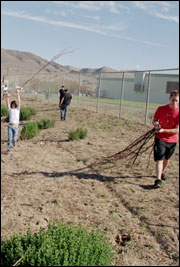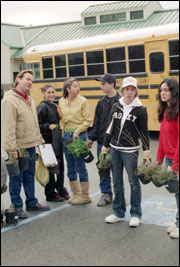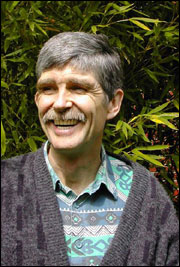Roland Saher Teaches Environmental Stewardship in Monterey Bay
by Walter Bonora
National Marine Sanctuaries
Learning about environmental stewardship of the Monterey Bay watershed through real-world, hands on experiences is a cornerstone of an innovative grant program known as the Bay Watershed Education and Training Program, or B-WET.
 | | Students clean up poison hemlock from a grassy area in preparation for planting. (Photo: Sam Madruga) |
Established in 2003 in the Chesapeake Bay area and expanded into California and the Hawaiian Islands, the program provides organizations with funds to support environmental education to teachers, students and communities throughout the watershed.
One teacher has taken teaching about government to new heights by showing students how government and politics are also connected to their environment. Roland Saher, an 11th grade government teacher at Anzar High School near Santa Cruz, Calif., is taking his class on a journey through government and economics by way of their local river watershed - the Pajaro River.
 | | Students will plant native grasses and other plants indigenous to the central coast of California to restore native vegetation. (Bruce Pirl, left, with clipboard, is one of Saher's colleagues. (Photo: Sam Madruga) |
"I am definitely treading on new ground here," says Saher, "by using an integrated approach to learning I show students the difficulties in getting diverse groups to buy into public policy for environmental stewardship." By understanding the environment, civic leaders can make the necessary decisions that affect both the environment and its citizens.
"The course at Anzar High school is a good example of the programs we like to support," said Seaberry Nachbar, the B-WET coordinator for the sanctuary. "Saher's course takes an integrated approach to learning which is a key goal of the program."
 | | Roland Saher (Photo: Sam Madruga) |
Born in Germany, the 57- year-old teacher who moved to California 30 years ago, has always felt a connection to the environment.
"I care about our natural world, and in particular our watershed environment here in California. Water is not a given in a state of 35 million people. We exact a great impact on our water supply with many types of pollution - chiefly agricultural run-off."
Another aspect of Saher's course is that he shows students up-stream and down-stream environmental conflicts. What is put in the water 100 miles away can often affect the river and the people downstream.
"We try to look at how erosion and pesticide run-off affects the entire river system and put that into a government context for the students," he said.
| 




